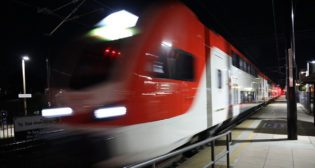
Amtrak Slashing Service. Will It Be Permanent?
Written by William C. Vantuono, Editor-in-Chief
Amtrak Executive Vice President and Chief Marketing and Revenue Officer Roger Harris: “Congress is not going to support us indefinitely to run mostly empty trains.” Photo: The Middletown Press
Citing a “need to be smart about how we deliver our service in this market environment” as well as “to demonstrate that we are using our resources efficiently and responsibly” because “Congress is not going to support us indefinitely to run mostly empty trains,” Amtrak Executive Vice President and Chief Marketing and Revenue Officer Roger Harris, in a June 15 letter to employees, announced drastic service cuts taking effect Oct. 1, 2020, the beginning of the railroad’s Fiscal Year 2021.
Harris began his announcement by saying that Amtrak “remain[s] committed to operating a national network that serves our customers across America.” Then, following his pronouncements about “smart” service delivery, “efficient” and “responsible” resource use and uncertain Congressional support, he announced plans for train frequency cuts of 32% on the Northeast Corridor and 24% for state-supported service, and a reduction for most daily Long-Distance trains to three days per week.
“This is an appropriate response, given the current and near-term market conditions,” Harris, who joined Amtrak in 2019 following 25 years as an airline executive, told employees. “During the COVID-19 pandemic, our ridership has been down by as much as 95% year-over-year. It’s climbing back slowly—and it is going to take a long time to return to normal. The demand for our Long-Distance service is down by 70%, even as some U.S. states begin to reopen. We expect our system-wide ridership in Fiscal Year 2021 to be only 50% of what it was in 2019.”
“Low ridership on Long-Distance trains has significantly increased our operating losses, which already exceeded $500 million annually on these services before the pandemic*,” Harris said. “We expect these Long-Distance frequency reductions will save as much as $150 million in FY21 vs. the losses that would have been incurred with daily service. These savings are part of our pledge to Congress to reduce costs by $500 million.”
Harris said Amtrak’s goal “is to restore daily service on these routes as demand warrants, potentially by the summer of 2021.”
“We recognize these changes will impact our employees who support the Long-Distance Service Line,” Harris continued. “While we have a broad plan on our FY21 service frequency, we still have work to do to determine how that will impact the employees who support this work. We are sensitive to the uncertainty that this announcement brings to our Long-Distance team. We will work quickly to determine what staffing reductions or furloughs will occur, and we will communicate these changes to you as soon as possible.”

Prior to his departure as Amtrak’s CEO (though he remains a consultant to his successor, Bill Flynn, through the remainder of 2020), Richard Anderson in a March 20 call-in town hall meeting for employees laid out “a survival plan whose core is to avoid involuntary furloughs,” according to Railway Age Capitol Hill Contributing Editor Frank N. Wilner.

Amtrak’s Auto Train is an exception to the Long-Distance reduction plan and will continue daily operation. The Sunset Limited and Cardinal are currently tri-weekly and will remain so. The Silver Meteor will operate four times a week so the stations that are common between it and the Silver Star have daily service.
“Amtrak remains concerned about the potential for a second wave of the pandemic in the fall, which could further impact demand across the system,” Harris said. “Amtrak is developing specific and measurable metrics to guide our restoration of frequencies and service, and we will share those with [employees], Congressional staff and other stakeholders. To ensure all stakeholders understand changes to our service, we will continue to communicate with our union leadership, our state partners, the federal government, the Rail Passengers Association, host railroads, our customers and you. We appreciate your continued support as we work together to manage Amtrak through this difficult period.”

Under the CARES (Coronavirus Aid, Relief, and Economic Security) Act, Amtrak in early April received from the Federal Railroad Administration (FRA) $1.02 billion “to support the railroad’s activities to prevent, prepare for, and respond to the spread of COVID-19 in the U.S. and its impacts on operations and business.” In late May, Amtrak CEO Bill Flynn submitted a letter to Congress requesting an additional $1.48 billion in supplemental funding for 2021. The additional funding is necessary for Amtrak to operate minimum service levels across the passenger rail network and continue capital investments for the future, the letter stated.
*Based on Amtrak’s non-GAAP financials, the subject of much criticism. Many advocates insist that Amtrak L-D trains are actually profitable.



